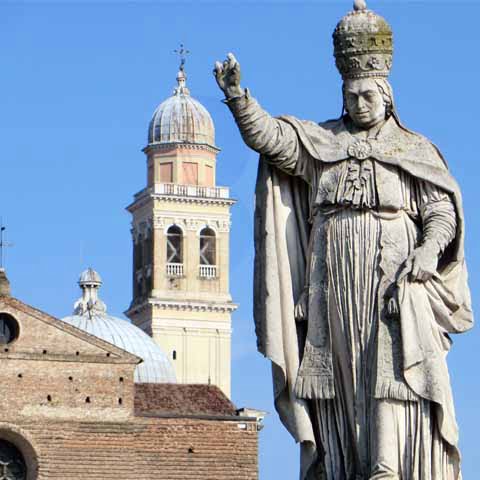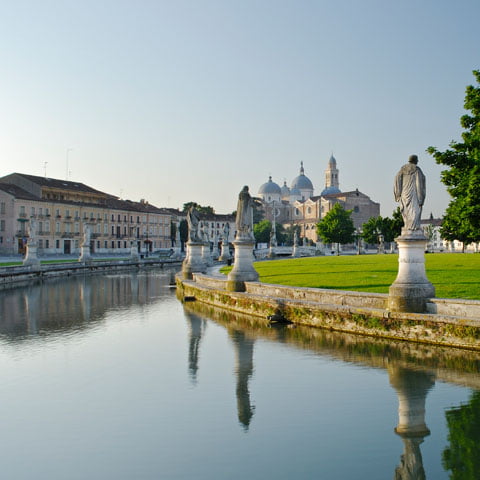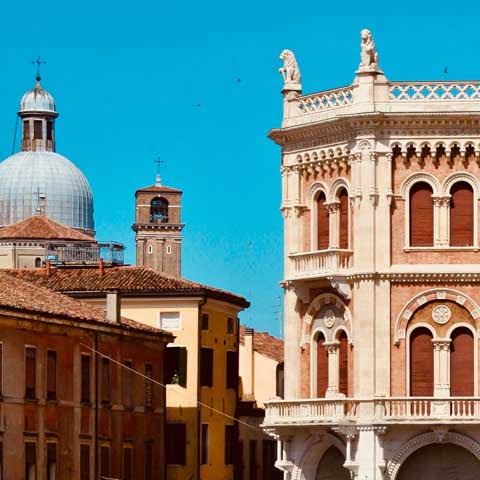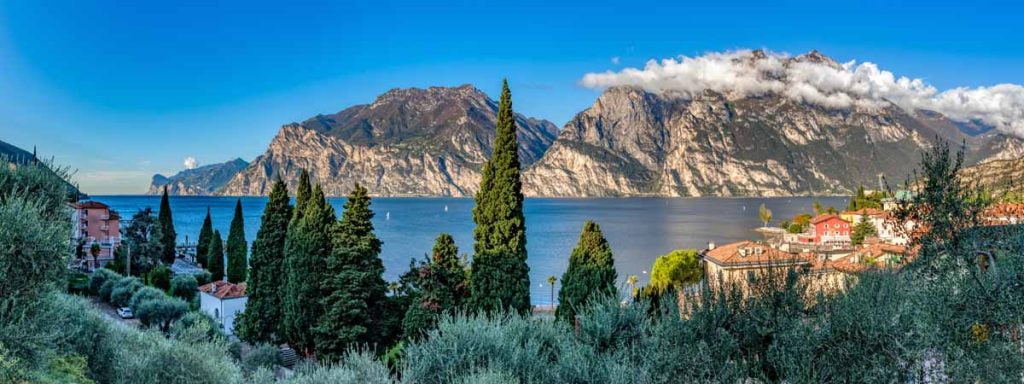Padova, or Padua in English, is the third largest city in the Veneto region, and, according to Virgil’s Aeneid, it was founded by Antenor, a Trojan prince, in 1185 BC. Following this tradition, the city is one of the most ancient settlements in Italy and in the Veneto region.
Although this hypothetical founding is only legendary, archaeological discoveries have confirmed that the city is of ancient origins.
The archaic nucleus most likely developed between the thirteenth and ninth centuries BC and is linked to the civilization of the ancient Venetians.
As one of Italy’s cultural capitals, Padova boasts important works of art including a splendid Giotto cycle that embellishes the Scrovegni Chapel. The city’s artistic splendor was one of the fruits of the cultural fervor favored by the lordship of the Carraresi family.
From a religious standpoint, Padova is universally known as the city of the Saint, since Saint Anthony, the famous Portuguese Franciscan, lived in Padova for a period and died in the city on June 13, 1231. Important pilgrimage destination for the whole Christian world, the city also hosts relics of St. Luke the Evangelist and St. Matthias.
As for the arts, in 1524 Padova received its first space dedicated entirely to theatrical performances called Loggia Cornaro, while in 1545, a group of theater performers formed a society of professional actors, symbolically beginning Italy’s Commedia dell’Arte tradition. Additionally, Shakespeare’s The Taming of the Shrew was set in Padova.
Padova’s long and varied history has influenced the city’s impressive art and architectural offerings as well as its rich cultural life and status as one of the hubs of the Veneto region.
PREHISOTRY OF PADUA
According to tradition, Padova was founded in 1185 BC by a group of Venetians led by Antenor, the only prince who survived the destruction of Troy. Indeed, the hypothetical tomb even rises in the square with the same name.
Legends aside, prehistoric settlements from as early as the eleventh century BC have been discovered in topographical correspondence with today’s center of Padova.
Representing one of the main centers of the Paleovenetian culture, ancient Padova was built on the banks of the Brenta River.
The Romans arrived in this area in 302 BC and helped the population reject a Spartan attack. To celebrate the victory, the Paduans dedicated a temple to Juno, remains of which are still visible today.
In 226 BC, Padova allied with Rome against Cisalpine Gaul, then showed its support towards Rome once again during the Second Punic War.
After three centuries of alliance, the city finally gained its municipium status in 49 BC and became one of the richest cities in the Empire, majorly thanks to the breeding of horses.
In the Augustan Age, it became part of the X Roman Regio, which had its capital at Aquileia. The assignation to this region came with important infrastructure development including the construction of Via Annia.
Remains from the Roman period include some bridges remodeled in the Middle Ages, the arena, as well as some remains from the baths, forum, and a column.
HISTORY OF PADUA
During the barbarian invasions between 452 and 453 AD, Padova was devastated by the incursions of the Huns of Attila.
After the fall of the Western Roman Empire, the city was involved in the wars raging between the Byzantine Empire and the Goths, allies of the Franks. Occupied by the Byzantines, it was subsequently involved in the wars against the Lombards.
The Lombards ultimately conquered Padova and razed it to the ground in 601. Some inhabitants sought refuge in the Venetian Lagoon, subsequently contributing to the birth of what would become the Republic of Venice.
At the same time, the main nucleus of the city went through a period of decline from which it rose only after the end of the Lombard Kingdom.
At the end of the ninth century, following the Hun raids, the territory became part of the March of Verona; initially part of the Carolingian Kingdom, it soon became part of the Duchy of Bavaria, and then, at the end of the tenth century, it passed under the Duchy of Carinthia.
The beginning of the eleventh century brought recovery, and the city established itself as an independent municipality.
Unfortunately, though, the twelfth century came with numerous disasters including several earthquakes and the great fire of 1174.
Nevertheless, despite these natural catastrophes, Padova also became a member of the Lombard League during this century, and in the years after 1183, it started to expand its importance and domains.
However, these expansionist ambitions drew the attention of the neighboring municipalities and especially of the Ezzelino and Onara families.
On the background of external struggles, the municipality of Padova kept flourishing, and in 1222 the city founded its first University.
Indeed, the University of Padova is the second oldest in Italy after the University of Bologna and it is one of the most prestigious in Europe. It is believed that St Anthony even preached there; from the beginning of the fourteenth century, the city began to witness a strong cultural movement.
Between 1303 and 1305, Giotto painted the Scrovegni Chapel with an artistic treasure that can still be admired to this day.
The expansion of the municipality was interrupted several times, especially during the bloody domination of Ezzelino III da Romano who slaughtered over ten thousand Paduans.
In the second decade of the fourteenth century, the political structure of Padova changed with the establishment of a Signoria. Jacopo da Carrara was elected as Capitano del popolo (Captain of the People), and in 1328, the city was conquered by Cangrande Della Scala.
As a consequence, Padova became part of the immense territory of Verona, but only for a short time.
During the following century, though troubled by continuous struggles with the neighboring lords and threatened by Venice, the city reached the pinnacle of its splendor and became the absolute protagonist of European art and culture.
Towards the end of the fourteenth century, during the battle of Castagnaro, Padova recorded a victory over Verona, and Francesco II of Carrara became the Lord of Padova. However, the new lord had to engage in immediate fights against Gian Galeazzo Visconti who allied with Venice in an attempt to win supremacy over the territory.
The military campaign of the Visconti, led by Jacopo Dal Verme and Francesco Delfino, ended with the subjugation of Padova, and the city was sold to Venice.
Nevertheless, thanks to the support of Florence and the consequent agreement with Venice, Carrara regained the domain of Padova again in 1390, forcing the Visconti militias to surrender.
However, soon after, Padova had to surrender to Venice once again in the so-called “devotion” of Padova to Venice. The events concluded with the dethroning of the Carrara who changed their name to Papafava.
During the Middle Ages, the lords of the city began important development and restoration works, including the emergence of the main hydraulic system of the province of Padova comprising the canals of Battaglia, Brentella, and Piovego.
For the following four centuries, though, Padova lost its political importance. This period was characterized by peace and prosperity ensured by the Venetian lordship. On the other hand, freedom was ensured by its University, which began to attract students from all over Europe.
Indeed, Padova became one of the major centers of Aristotelianism, a true magnet for illustrious intellectuals, including Galileo Galilei.
However, this situation was about to come to an end with the turn of the sixteenth century, during an anti-Venetian siege promoted by the League of Cambrai.
Despite the events, the seventeenth century was, all in all, rather quiet from a political and military standpoint. The city remained under Venice; nevertheless, the events at the end of the sixteenth century marked the beginning of the descending parabola of its millennial history.
Due to a provision by Venice, all adult males belonging to noble families were automatically enrolled into the municipal council. In reality, however, the council had no superior power and only remained the prerogative of the central structures of the Venetian Republic.
The War of Candia between 1645 and 1669 was the occasion for some Paduan families to be admitted into the Venetian aristocracy.
However, the city’s situation only changed in the eighteenth century when socio-political and cultural upheavals – in both Padova and the rest of Europe – made their echo felt throughout the Old Continent.
The fall of Venice had foreseeable repercussions on the city with Padova being occupied by the French.
Despite the political struggles for power, though, Padova also received many important buildings during this period. One of the most noteworthy is the founding of the civic hospital on the initiative of Bishop Nicolò Antonio Giustiniani.
After a brief occupation by the French, the city was ceded to Austria as a result of the treaty of Campoformio. Then, it became part of the Lombard-Veneto Kingdom in April 1815.
In 1842, the Padova-Marghera section of the Ferdinandea railway opened, which is now known as the Venice-Milan line.
In 1848, the city saw an insurrection against the Austrian occupation, a movement led in particular by the university students.
Vittorio Emanuele II entered Padova in 1866, and following the plebiscite of 21-22 October 1866, the city was annexed to the Kingdom of Italy alongside the entire Veneto region.
During World War I, due to the proximity to the battlefront, the city became the seat of the High Command, including that of the Third Army. Numerous logistic departments and the hospital were bombed on several occasions.
On the evening of November 11, 1916, an Austrian bomb hit an air-raid shelter in the Gatta bastion. The blast hit the crowds trying to escape and caused 93 deaths and left several wounded.
World War II was equally devastating for Padova. Over the progression of the war, the city lost priceless paintings as well as important frescoes from many churches around the city.
The postwar years brought continuous economic development thanks to the favorable geographical position at the center of important communication routes. The city developed its industries and services, but also its university.
Starting in the 1960s, the city became the pivot of the gradual economic transformation of the province of Padova from an agricultural economy towards an economy based on services.
The university and the hospital progressively expanded their already considerable national scientific relevance, gaining a central role in the articulation of the local economy.
Today, the city is experiencing major urban changes characterized by the construction of new executive and residential buildings. Among them, the most important is the Net Center.
Numerous urban redevelopment projects planned for the many areas outside the city center also contribute to changing the aspect of the city, while maintaining the cultural spirit of the historical city center.
ARCHAEOLOGY IN PADUA
Like the entire Veneto region, Padova was inhabited from the earliest times, yet most archaeological evidence dates from the Roman era.
Indeed, scattered throughout the region, are the remains of many Roman bridges and aqueducts.
The Roman Arena of Padova is a recently discovered archaeological site that can be visited. Furthermore, the remains of three Roman Domus and a necropolis, now included in the archaeological area of Santo Stefano, have been discovered.
Ancient remains from Padova and the province are also exhibited in the National Archaeological Museum of Padova and the Civic Museum of the Eremites.
Travel Guides
The Veneto Region of Italy
The Cities of Veneto, Italy









